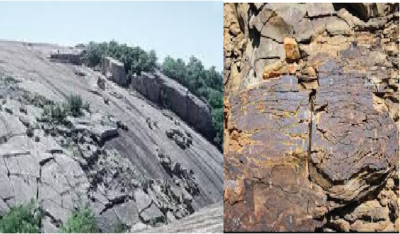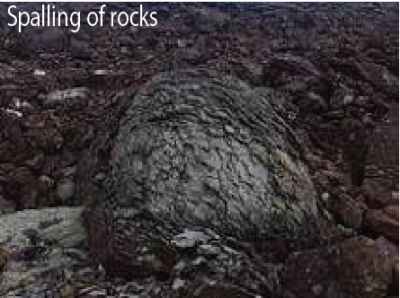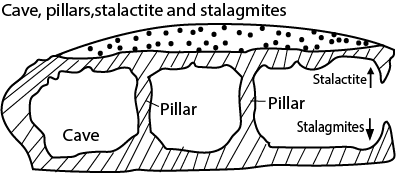
Physical geography Chapter 5: Weathering in East Africa

Weathering is a denudation process which involves physical disintegration and chemical decomposition of rocks in situ (one place) by natural agents on the surface or near the Earth’s surface
There are two types of weathering that take place in East Africa.
Physical/mechanical weathering is disintegration /break down of rocks into small fragments with no change in the rocks chemical composition in situ
Physical weathering is common in Semi-arid and arid areas such as Karamoja, Turkana land, Central Tanzania etc. as well as glaciated mountains such as Kilimanjaro, Kenya and Rwenzori.
The major processes of physical weathering include;·
- Exfoliation/onion peeling which is the peeling off of surface rock layers due to heating during day causing expansion and cooling at night causing contraction. Exfoliated domes in East Africa exist at Mubende and Nakasongola in Uganda, Serengeti etc. outstanding exfoliation domes are the Hells gates at Naivasha and Mubanda rocks along Nairobi-Mombasa Highway.

- Block disintegration occur in hot regions and involves breakdown of jointed rocks into rectangular shaped blocks due to heating during day causing expansion and cooling at night causing contraction.
- Granular disintegration is a form of physical weathering where a rock breaks into small particles called granules. It is mainly observed in rocks with different colored minerals such granite rocks constitute of mica, quartz and feldspar which have different heat absorption and linear expansivity capacities. Granular disintegration is found at Mubende and Nakasongola in Uganda, Turkana in Kenya, etc.

- Aridity shrinkage or slaking occurs on non-porous rocks like clay which absorbs water during rainy season and expands, while during dry season lose water through evaporation and crack. Repeated alternative expansion and contraction eventually cause them to crumble into small elongated pieces. This kind of weathering is common in swamps or areas with clay such as Masai-mara plains in Kenya, Nasongola and Tororo in Uganda.
- Frost wedging/Frost shattering occurs in places where temperature falls below 00C such glaciated mountain tops of Kilimanjaro, Kenya and Rwenzori. During day snow or ice melts and water enters into rock cracks. During night water in these cracks solidifies and expands causing pressure that breaks rocks into small pieces.
- Pressure release/unloading takes place on granite or metamorphic rocks. Expansion and cracking takes place because large shear stresses under the surface that bends leading to exfoliation of rocks/spalling/sheeting. This form of mechanical weathering can be caused by freezing and thawing, unloading, thermal expansion and contraction, or salt deposition. It common on Nakasongola and Mubende Inselbergs.
- Unloading/ pressure release while is the process by which newly exposed rock due to mass wasting expand and break due to release of weight caused by pressure.

- Salt crystallization which is process where saline solutions in rock cracks and joints begin to crystallize causing stress on the rock resulting into its disintegration
The factors that cause physical weathering
- Climate
- In areas of hot climate such as Turkana region in Northern Kenya, Central Tanzania, during the day it is hot, exposed rocks are heated leading to expansion of the rock, while during the night, temperatures rapidly fall leading to rapid cooling of rock resulting into contraction. Such alternate expansion and contraction of a rock lead to peeling or breaking of the rock through processes like exfoliation, granular disintegration, block disintegration etc.
- In Semi – Arid areas such as Central Tanzania, during the short rainy season, non-porous rocks like clay absorb water and expand while during the long dry season they lose water and crack resulting into rock disintegration..
- In Semi- Arid areas there is limited cloud cover which leads to temperature fluctuations i.e. hot/very hot during the day, cool/cold during the night leading to expansion and contraction, resulting into breakdown of rocks.
- On high mountains of East Africa, the temperature fluctuations result into frost weathering which is the process by which water collects in cracks during the day and during the night water freezes, volume increases causing pressure and breaking of the rock
- Nature of parent rock.
- Jointed rocks such as limestone in Turkana, Kotido and Moroto areas result into block disintegration when rocks break into rectangular blocks when repeatedly heated or cooled.
- Mineral composition- Rocks having different minerals absorb heat and lose heat at different rates when heated or cooled respectively resulting into granular disintegration.
- Color of the rock- dark colored rocks absorb a lot of heat in Semi – Arid areas when heated leading to their disintegration.
- Differences in rock hardness. Soft rocks such as limestone in semi-arid areas like Turkana, Kotido easily break down when exposed to rapid cooling and contraction due to hot temperatures during day and cold during the night.
- Relief
- Steep slopes tend to experience to experience a lot of soil erosion that expose rocks to process of physical/mechanical weathering.
- Steep slopes tend to be affected by mass wasting that expose the rock to unloading/pressure release which is in form of mechanical weathering.
- Limited vegetation cover in semi-arid areas like Turkana, central Tanzania, Moroto exposes the rock to extreme temperature fluctuation resulting into rapid expansion during day and rapid contraction at night leading to rock disintegration.
- Biotic factors
- Movement of heavy animals like elephants, antelopes, zebra in Kidepo National Park lead to breaking of rocks
- Burrowing animals like squirrels, Hog and insects like locust, termites destroy vegetation thus exposing rocks to physical weathering due to temperature fluctuations.
- Effects of plants adapted to semi-arid areas like cactus, acacia grow strong roots into and break rocks
- Human activities such as quarrying cause disintegration of rock
- Time: the longer the time the more physical weathering occurs.
Chemical weathering
Chemical weathering is the decomposition of rocks due to chemical reaction that takes place between the rock minerals, water and atmospheric gases like oxygen and carbon dioxide causing changes in chemical composition. Chemical weathering dominates areas of heavy rainfall and high temperatures such as L. Victoria basin, Kigezi highlands, Kenya highlands, coastal areas like Mombasa.
Types of chemical weathering
Solution
This is where soluble mineral components in rocks are dissolved by water e.g. rock salts are carried in solution leaving behind joints, cracks/widened hollows in rocks.
Oxidation
This is the reaction between oxygen and mineral components in rocks such as iron, aluminum facilitated by the hot temperatures and existence of water. This has led to the formation of laterites for example on the flat-topped hills of Buganda, Rocks containing Iron (ferrous state) change to ferric state.
Hydrolysis
This is the reaction between the hydrogen ions from water and mineral ions from rocks to form new compounds. It the major process in of decomposition of feldspars in igneous rocks e.g. granites.
Carbonation
This involves rain water dissolving atmospheric carbon dioxide to producing carbonic acid. This reacts with calcium and magnesium carbonates in the rocks to form to form soluble bicarbonates that are lost in solution.
Hydration
This is a process in which certain minerals absorb water and expand causing internal stress and fracturing of the rock. Examples include the conversion of hematite to limonite, mica in sedimentary rocks like sandstone.
Spheroidal weathering
This is the swelling/expansion of the outer shell of a rock mass by penetration of water forcing them to expand, loosen and and peel successively away.
Reduction/gleying
It is the removal of oxygen from a substance or addition of hydrogen to it Occurs in swampy/water logged areas at the shores of lake Victoria. It involves anaerobic bacteria absorbing the limited oxygen leaving behind hydrogen that reacts with the rocks to form new compounds i.e. the clay rich rocks turn into blue greyish colour.
Chelation
This involves base exchange between plants and rocks which cause chemical changes and rock disintegration.
The factors that favor chemical weathering
Mineral composition of the rock
- Rocks that contain calcium carbonate/limestone dissolve in water that contain carbonic acid e.g. at Tororo in eastern Uganda and Nyakasura
- Rocks like feldspar hydrolyze in water into other compounds such as potassium ions, kaolinite (clay) and silica.
- Rocks that contain iron are oxidized in presence of water and oxygen.
- Rock-salt (halite), gypsum and limestone (including chalk)dissolve in presence of water
- Igneous rocks are easily hydrated and hydrolyzed because they are composed of silicate minerals, such as quartz and feldspar which readily combines with water
Nature of rocks
Presence of cracks in jointed rocks increases surface area to agents of chemical reaction
Permeable rocks allows water and oxygen to penetrate leading to hydrolysis and/or oxidation
Climate
- Rainfall provides water for hydrolysis of rocks
- High temperature speeds up chemical reaction in rocks
Relief
- Chemical weathering is dominant on gentle slope and low land because these allows percolation of water in the rocks to allow chemical weathering
- Steep slopes promotes removal of weathered materials by erosion exposing rocks to agents of chemical weathering
Biotic factors
- Plants produce humic acid that facilitate rock decomposition
- Man influences chemical weathering by releasing acidic gases/substances to the atmosphere which cause acidic rain/water. Acidic water promotes hydrolysis of rocks
Time
The longer the time the more physical weathering occurs
Landforms resulting from chemical weathering in East Africa
These include
Stalactite and stalagmite
These are formed through carbonation. Rain water combines with carbon dioxide in the atmosphere to form weak carbonic acid which dissolves calcium carbonate to form calcium bi carbonate. When solution reaches underground cave, calcium carbonate is deposited on roof of the cave to form stalagmite e.g. at Nyakasura in Western Uganda.
Pillars
These are vertical stands of calcium carbonate formed in underground caves when stalactites and stalagmites continue to grow towards each other and eventually join. Examples arc found at Nyakasura and Tanga.
Caves
A cave is a natural underground space. It is formed when there is chemical dissolution of limestone or dolomite. The rock is dissolved by natural acid in ground water that seeps through the bedding planes, faults and joints.

Grikes and Clints
Grikes are hollows or depressions while Clints are ridges formed as a result of carbonation. They formed in limestone areas with rocks of different chemical composition. Lime stone is dissolved by acidic rain to form depressions/ hollows called Grikes while dissolved rocks form ridges called Clints/ Limestone pavement.

Examples are found on the western side of Tororo rock, Karasuka in Karamoja, Nyakasura etc.
Arenas/Sink holes
A sink hole is a natural depression or hole in earth’s surface formed when lime stone is dissolved. It is formed through the processes of removal of soluble rock by percolating water and the collapse of roof cave.
Dolines:
These are larger than sinkholes. These are shallow circular depressions formed either by solution of the surface lime stone or by collapse of underlying caves. In latter case they are called collapse doline.
Polje.
This is an elongated basin having a flat floor and steep walls. The poljes are formed by coalescence of several sinkholes when being formed through carbonation and solution. In some poljes, small residual hills known as hums are formed.
Limestone gorge is deep steep-sided valley formed when acid rain seeps into the cracks in limestone rocks or when a larger river erodes/ weathers soft limestone rocks by solution.
Duricrust is a hard crust (layer) found on the surface formed from mineral precipitation i.e. deposition of insoluble materials from a solution. The most common in East Africa is lateritic duricrust formed when the weathered layer become impregnated with iron solution due to leaching. On removal of top layer laterite hardens into duricrust like on flat topped hills of Buganda/ laterite terms·.
Tors are landforms created by chemical weathering of a rock along joints followed by removal of the weathered material.
Differences between physical and chemical weathering
- In physical weathering there is no change in the chemical nature of the rocks that are broken into small particles while in chemical weathering there in a change in chemical composition of a rock
- Physical weathering occur in form of block disintegration, exfoliation, granular disintegration, frost weathering while chemical weathering involves decomposition/decay of rocks into new compounds by reactions like oxidation, hydrolysis, hydration etc.
- Physical weathering commonly occur in arid areas with high temperature fluctuation while chemical weathering commonly occur in areas of adequate rainfall
- Physical weathering no new compounds formed while chemical weathering new compounds are formed
Revision questions
- Examine the weathering processes taking place in East Africa.
(Define weathering, identify and describe each weathering types, give occurrence of each type of weathering in East Africa))
- Physical weathering dominates in the arid areas of East Africa. Discuss
(Define physical weathering, identify arid areas in East Africa, factors that promote the types of physical weathering in East Africa, describe chemical weathering as alternative to physical weathering)
- (a) Distinguish between physical and chemical weathering
(Define the terms physical and chemical weathering and then give differences between physical and chemical weathering)
(b) Describe the factors which have favored chemical weathering in East Africa.
- Describe the chemical weathering process in humid areas in East Africa
(Define the term chemical weathering, identify humid areas in East Africa, describe factors that favored chemical weathering, describe chemical weathering processes)
- Examine the factors that influence the type and rate of weathering in East Africa
(Define weathering, identify the types of weathering, then explain the factors that influence the type and rate of weathering)
- To what extend does the rate and character of weathering depend on the nature of rocks?
(Define weathering, bring out the extent to which the nature of rocks (mineral composition, rock hardness, color of rock, rock joints) influence the character of rate of weathering; discuss the alternative/other factors that affect the rate of weathering as well)
- (a) distinguish between physical and chemical weathering
(b) Examine the importance of weathering process on landform formation in East Africa
- Account for the landform produced by carbonation process in East Africa
- (a) What is chemical weathering
(b) Describe the landforms resulting from chemical weathering
- Examine the weathering processes that take place in the L. Victoria basin of East Africa.
(Define weathering, identify location of L. Victoria basin, discus both chemical and physical weathering process.

Thanks so much
Good
Mr that is amazing
Thank
Thanks so much teacher
Thanks
You have a gift for explaining things clearly. Stationary
I’m always amazed by your depth of knowledge. Indian Cricket
Explore quality educational options with MBBS Admission Through Management/Nri Quota in West Bengal.
Get detailed insights into tuition fees at MBBS Fees Structure in Punjab.
Join Raja Luck to participate in engaging games and exciting challenges.